Coronavirus Today: How to navigate Pandemic Thanksgiving 2.0
- Share via
Good evening. I’m Karen Kaplan, and it’s Tuesday, Nov. 23. Here’s the latest on what’s happening with the coronavirus in California and beyond.
Now that we’re 20 months into the pandemic, you might think we’d have run out of tricky new situations to navigate. But this Thanksgiving marks the first major holiday since COVID-19 vaccines have been widely available to almost everyone, and that presents some dilemmas we haven’t faced before.
A year ago, we were in the opening weeks of the devastating fall-and-winter surge that saw about 3 million Californians test positive for coronavirus infections and cost more than 43,000 lives. Los Angeles County health officials were advising people not to celebrate Thanksgiving with people outside their own households. If you wanted to play it safe, the path was clear.
This time around, case rates and deaths seem to be holding steady, and anyone who’s at least 5 years old can get a COVID-19 vaccine, protecting themselves and those around them. We have more options for celebrating Thanksgiving safely.
All that ought to seem like a dream come true. But when family members can’t agree on what feels safe, the resulting conflicts can be a nightmare.
It’s not like Americans aren’t used to family conflicts at Thanksgiving. You may cringe when your aunt talks politics over dinner or when Grandpa praises your favorite team’s rivals while you’re watching football on TV. Debates about COVID-19 safety raise the emotional stakes to new heights because they can mean the difference between life and death.
One of the clearest dividing lines is between those who are vaccinated and those who aren’t. A recent survey by the Harris Poll found that half of respondents who were vaccinated were either “extremely” or “considerably” wary of spending holidays with relatives and friends who hadn’t taken advantage of the shots. And that wasn’t just lip service: 42% of vaccinated survey takers said they’d already canceled at least one event or travel plan because the people they’d been planning to meet were not vaccinated.
When Cassie Fowler of San Marcos decided to resume her usual Thanksgiving hosting duties after last year’s hiatus, she hoped to head off conflicts by addressing the issue head-on in a group chat.
“Hello, family!!” Fowler typed. “To ensure everyone feels comfortable and safe, we are asking for everyone to please provide proof of vaccination *OR* a recent negative COVID test (within 3 days).”
Family members had the option of sharing pictures of their vaccine cards with the whole group or sending them directly to Fowler, who kept track of everything on a Google doc studded with syringe emojis.
The proactive approach was designed to avoid the tense situation prompted by a family birthday dinner a couple of months back; one vaccinated person said they wouldn’t go if a certain unvaccinated relative would be in attendance. The terms of her Thanksgiving invitation were inspired by the Hollywood Pantages Theatre, which offered similar options when she went to see “Hamilton.”
And it seems to have worked. Fowler didn’t expect the unvaccinated relative to have a change of heart, but this way everyone could feel both welcome and safe.
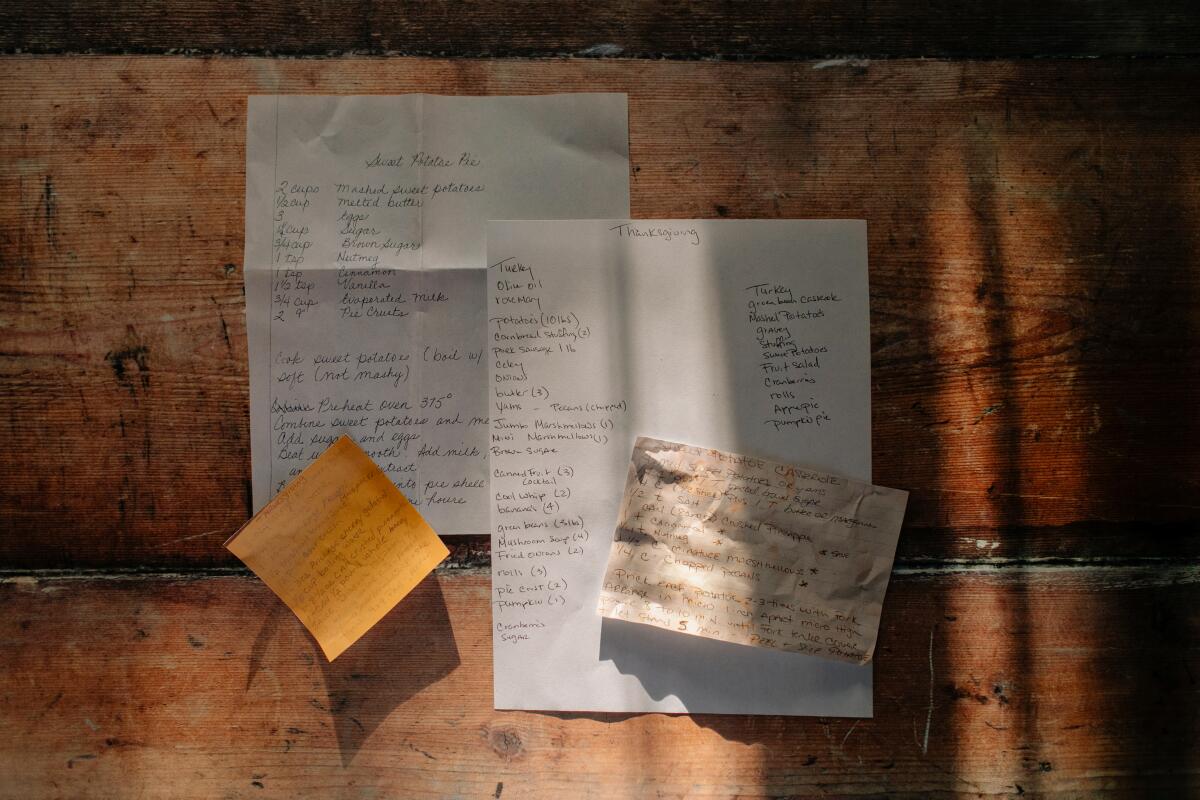
Mary Lyn Martinez also put her usual Thanksgiving traditions on hold last year. She has let her guard down since getting vaccinated, but a family gathering in August for her mother’s funeral exposed a vaccination rift she’s not ready to deal with.
Martinez, her husband, her children and their spouses are all vaccinated. So are all but one of her grandchildren (he’s too young to be eligible for a shot). They will be at her Acton home on Thursday.
Not attending will be Martinez’s sister from Arizona, who says she’s confident her immune system can fight the virus without help from a COVID-19 vaccine. The sister had hoped to be able to hold the grandson when she came for the funeral, even though she wasn’t vaccinated. Martinez turned her down.
The exchange was a factor in her decision to once again limit her Thanksgiving celebration to immediate family.
“It’s just us this year,” Martinez said. “Instead of looking for a 27-pound turkey, I’ll be looking for a 12-pound one.”
I sincerely hope you enjoy your Thanksgiving, however you plan to spend it. We’ll be taking the day off on Friday and will be back in your inbox next Tuesday.
By the numbers
California cases and deaths as of 4:20 p.m. Tuesday:

Track California’s coronavirus spread and vaccination efforts — including the latest numbers and how they break down — with our graphics.
How to set ground rules for your holiday gathering
Perhaps Cassie Fowler and Mary Lyn Martinez have inspired you to be upfront with your Thanksgiving guests and address vaccines and other COVID-19 issues plainly instead of hinting around and hoping for the best. If so, my colleague Karen Garcia from our Utility Journalism team has some useful advice.
Let’s start with this: There’s no need to feel awkward about asking guests if they’re vaccinated. The same goes for guests who want to ask hosts about the vaccination status of other invitees.
“This isn’t a decision about whether you want to spend time with them,” said Dr. Curley Bonds, chief medical officer for the L.A. County Department of Mental Health. “It’s more about wanting to be safe, and I think it’s really important to be honest about that.”
Nor should you be shy about asking guests to wear a mask, eat outdoors, or take a rapid COVID-19 test before they come over. The same principle applies — it’s not about you, it’s about keeping all of us safe and comfortable.
Another thing to keep in mind: We’ve all experienced the pandemic differently. Someone who’s weathered a severe case of COVID-19 or lost a loved one to the disease is likely to weigh risks and benefits differently than someone who doesn’t know anyone who’s tested positive for an infection. Remind yourself of this if you feel yourself becoming judgmental.
“This isn’t the time to get into big elaborate debates about ‘Why you haven’t gotten vaccinated?’” Bonds said. “You want to be respectful.”
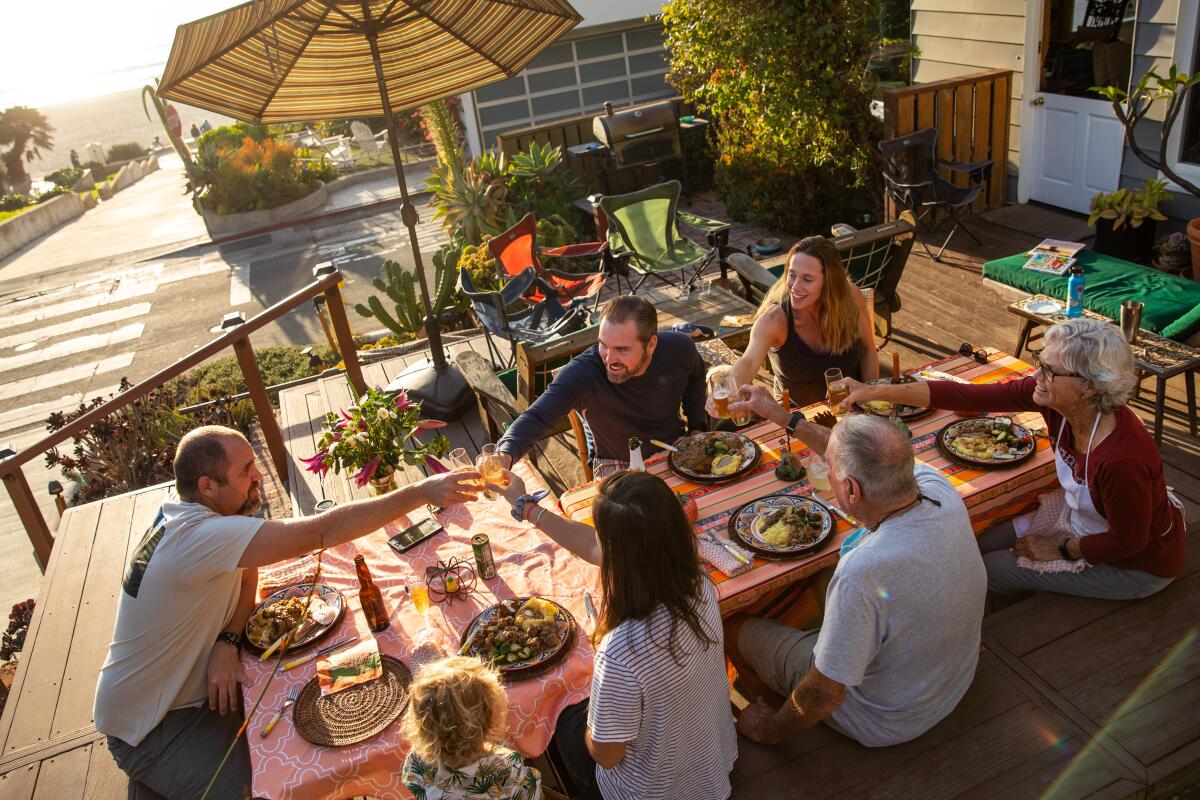
Keeping politics out of the conversation will increase your odds of finding a solution that can allow you to include unvaccinated friends and family in your celebration without sacrificing safety. It will also keep a disagreement from spiraling into an all-out feud.
“We are deeply polarized,” said Ted Andrews, a family mediator. “Even though this conversation will be between two people, our minds are so packed with tweets and posts that anything said will bounce off this clutter and take us somewhere unintended.”
Should that happen, remember that one argument about COVID-19 need not be the final verdict on your entire relationship.
“Families and friends can outlast politics and pandemics,” Andrews said.
You can begin to mend fences by simply thanking each other for being willing to talk in the first place. Even if you can’t find a way to get together in person this Thanksgiving, let your loved ones know they’re important and you’ll be eager to see them when all this is over.
If you’d like help deciding whether various types of holiday gatherings are safe for you at this stage of the pandemic, check out this interactive story to help you think through the risks — and what to do about them.
And if you’re having trouble finding things to feel thankful for as the pandemic drags on, read this story to be reminded of eight things that used to be scary but no longer cause us grief.
California’s vaccination progress
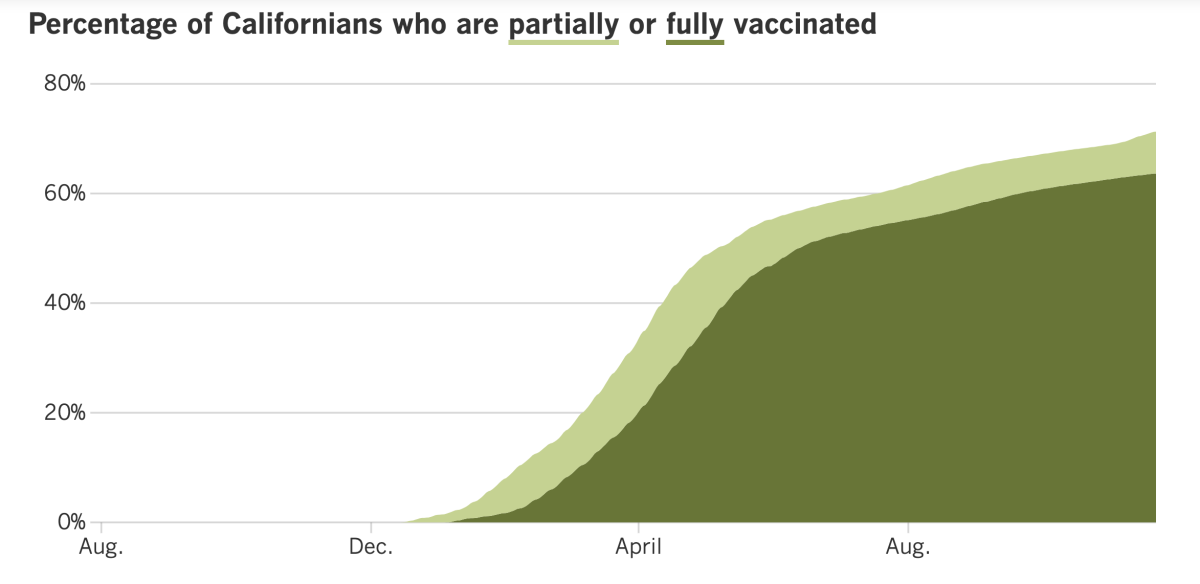
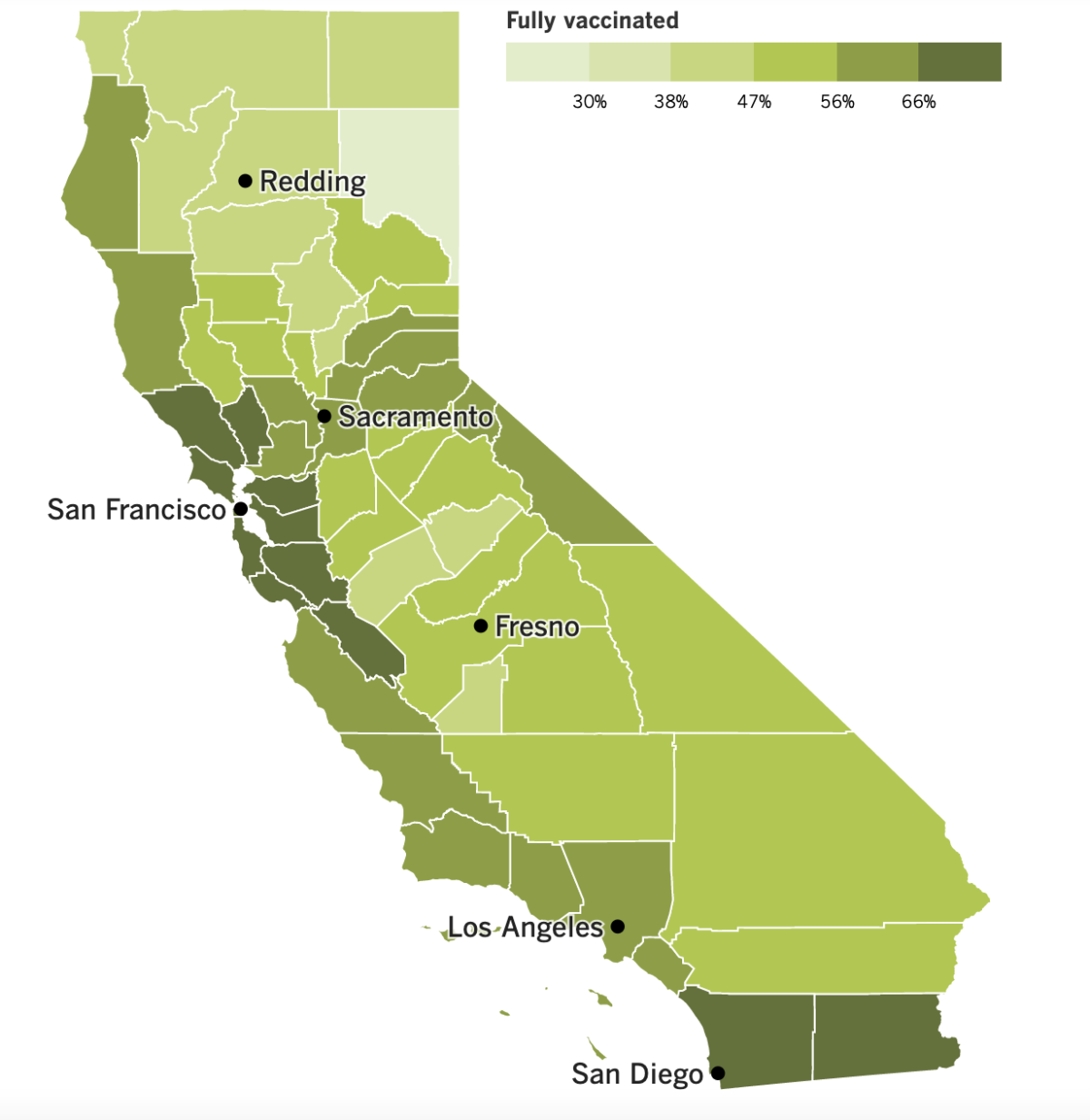
See the latest on California’s vaccination progress with our tracker.
Your support helps us deliver the news that matters most.
In other news ...
Nearly 4 out of 5 students in L.A. Unified who are required to comply with the district’s COVID-19 vaccine mandate are on track to do so. Sunday was the deadline for students ages 12 and older to get their first dose of the Pfizer-BioNTech vaccine, though they could still become fully vaccinated in time to meet the final deadline if they get the first of their two doses by the first week of December, my colleague Howard Blume reports.
About 225,000 students are subject to the mandate; that means roughly 45,000 students are not yet in compliance. School officials hope some of those kids actually got their shots but just haven’t uploaded the necessary documentation yet. Failure to meet the Sunday deadline — either by uploading proof of vaccination, obtaining a medical exemption or getting an extension — did not come with any immediate penalties.
Though a compliance rate of close to 80% sounds high, failure to improve it would leave tens of thousands of students displaced from in-person classes when the spring semester begins on Jan. 10. They’d have to enroll outside the district or transfer into City of Angels, the online independent study program that has been adapted — not always successfully — to include some real-time instruction.
While we’re on the topic, more than 95% of federal government workers have met their first deadline to comply with President Biden’s vaccine mandate. That includes more than 90% of workers who have received at least one dose of vaccine; the rest met Monday’s deadline by requesting an exemption in time.
More than 3.5 million people are subject to this vaccine mandate. Those who missed the deadline will begin a “counseling” process that could end in termination if they don’t get vaccinated and aren’t approved for an exemption.
Back to California, where the surge in the central part of the state has become so dire that health officials there want to make it easier to transfer hospitalized COVID-19 patients to Los Angeles County and other areas.
In Fresno County, the COVID-19 hospitalization rate is four times higher than in L.A. and Orange counties, and more than five times above the rate in the San Francisco Bay Area. (Only 55% of Fresno County residents are fully vaccinated, compared with 65% in L.A. County, 66% in Orange County and 78% in San Francisco.)
Across the entire San Joaquin Valley, hospitals are “often running over capacity,” said Dr. Rais Vohra, the Fresno County interim health officer. Patients are backing up into emergency departments, and ERs are so full that ambulances have to wait to unload their charges or drive them further away, even when they need time-sensitive treatment for conditions like strokes.
My colleague Rong-Gong Lin II reports that it’s not clear why hospitals in Fresno County and elsewhere are having trouble transferring patients to other parts of the state. For its part, the L.A. County Department of Health Services said it “welcomes patients from other counties” so long as services are “readily available” to residents here.
In Sacramento, the state health department has released a long-overdue report on a troubled COVID-19 testing lab it ran in partnership with PerkinElmer, a diagnostics company based in Massachusetts.
Among other things, the lab allowed more than half its workers to process, test and report patient samples on their own without first making any assessment of their competency to do so. The lab also lacked a policy for informing patients that the results they received were incorrect, and if a specimen went missing or was mishandled to the point that it wasn’t usable, workers shifted the blame by calling it an “unsatisfactory sample,” according to state investigators.
The Newsom administration had promised a full report on the Valencia Branch Laboratory in March, but it was not released until Monday. By then, the state had renewed a $1.7-billion, no-bid contract with PerkinElmer to keep running the site, one of the largest in the state.
No sanctions were issued in connection with the report’s findings. In fact, the report praised the lab for processing more than 5.5 million tests, including many specimens from high-risk communities
In Europe, frustration over continued COVID-19 countermeasures has led to protest marches in Brussels, Rome, Vienna, Zagreb, Croatia, and other major cities.
Tens of thousands of people have turned out in recent days to make their displeasure known. In the Dutch city of Rotterdam, protests sparked rioting, which prompted police to respond with live fire. Four people sustained gunshot wounds as a result.
“We live in Western Europe and we just want to be free, how we were before,” said Eveline Denayer, one of 35,000 people who marched in Brussels on Sunday.
That won’t happen until more people get vaccinated and the Delta variant is no longer running rampant, government officials say. But it’s something of a chicken-and-egg problem: Case numbers are rising because too few people are vaccinated, health experts say, but the rising case numbers are feeding into vaccine hesitancy.
The World Health Organization’s Europe office emphasized the stakes Tuesday with a new projection showing its 53-country region could face 700,000 additional deaths by next spring. That would increase the number of COVID-19 deaths there to more than 2 million in total.
We’ll give the last word to Dutch Prime Minister Mark Rutte.
“I realize that there are a lot of tensions in society because we have been dealing with all the misery of coronavirus for so long,” he said. But the people who encourage riots and target police, firefighters and ambulance drivers are “idiots.”
Your questions answered
Today’s question comes from readers who want to know: Are there any COVID-19 restrictions for my out-of-town visitors?
Yes and no.
If you have people coming to L.A. for the holidays, they’ll have to follow the same rules as everyone who’s already here. But they won’t have to jump through any additional hoops on account of their out-of-town status.
In the city of Los Angeles, both you and your guests will need to provide proof that you’re fully vaccinated against COVID-19 before you can enter all kinds of indoor businesses. These include:
- Restaurants, bars, food courts and coffee shops
- Gyms and group fitness classes
- Shopping centers
- Pool halls, bowling alleys, arcades and card rooms
- Cinemas, theaters and concert venues
- Salons, barber shops and tattoo parlors
Would-be patrons who are not fully vaccinated may still be served outdoors, and they can enter a business briefly to pick up a to-go order or to use a restroom (as long as they’re wearing a mask that covers their nose and mouth).
If you’ll be taking your visitor to an outdoor event or attraction attended by at least 5,000 people, you’ll also need to flash that proof of vaccination or else produce a negative COVID-19 test result that’s less than three days old.
Elsewhere in L.A. County, you and your visitor will need to provide proof of full vaccination to gain entrance to the indoor portions of bars, breweries, wineries, distilleries, nightclubs and lounges. Outdoor service is permitted for those who are unvaccinated.
“Full vaccination” means you’ve had both doses of either the Pfizer-BioNTech or Moderna vaccines, or the single dose of Johnson & Johnson vaccine, and that it’s been at least two weeks since your final dose. Though booster shots are recommended for adults two months after the J&J shot and six months after the second dose of the mRNA vaccines, they are not required to be considered fully vaccinated.
There are multiple ways to prove your vaccination status, including flashing your white COVID-19 vaccination record card from the Centers for Disease Control and Prevention (a photo on your phone or paper copy will do). If your visitor was vaccinated in another country, the equivalent card from that country’s health agency will count, as will the yellow record card from the World Health Organization.
Digital vaccination records are also acceptable if they’re from the state of California or a recognized issuer like Healthvana. QR codes from the SMART Health Card program will work too.
We want to hear from you. Email us your coronavirus questions, and we’ll do our best to answer them. Wondering if your question’s already been answered? Check out our archive here.
The pandemic in pictures
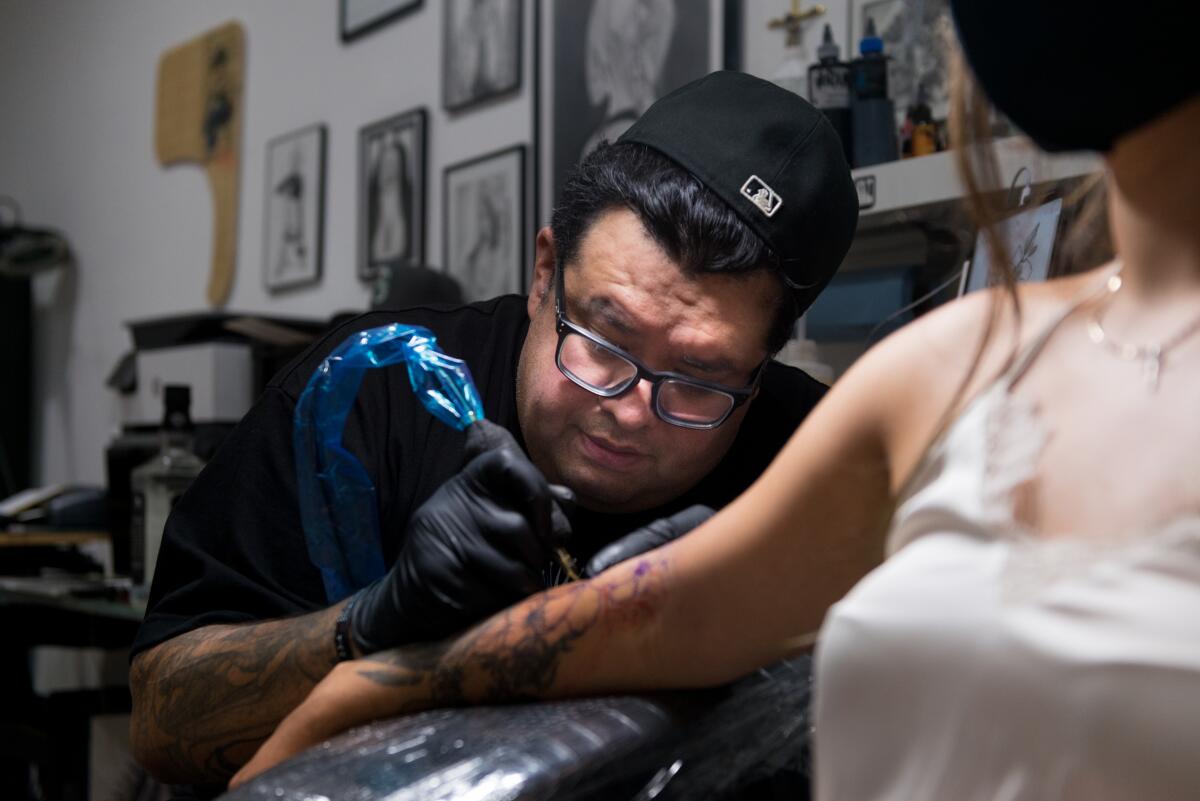
The woman with the outstretched arm above is Sazalea Martinez. She’s having an image of azaleas inked into her skin, along with the phrase “I love you.”
The flowers are a representation of Martinez’s grandfather, and the three words are written in her grandmother’s handwriting. Both of her grandparents — the people who “basically raised me,” she said — died this year of COVID-19, and she decided to honor them with a memorial tattoo.
“They impacted who I am as a person,” she said, “so to have them with me will be comforting.”
The artist working on Martinez is Juan Rodriguez, owner of FTF Tattoo in Pacoima. He said business had doubled since the pandemic, with clients booked out months in advance.
Deborah Davidson, a sociologist at York University in Toronto, wouldn’t be surprised to hear that. According to her research, at least 80% of tattoos are meant to commemorate someone.
“Memorial tattoos help us speak our grief, bandage our wounds and open dialogue about death,” Davidson said. “They help us integrate loss into our lives to help us heal.”
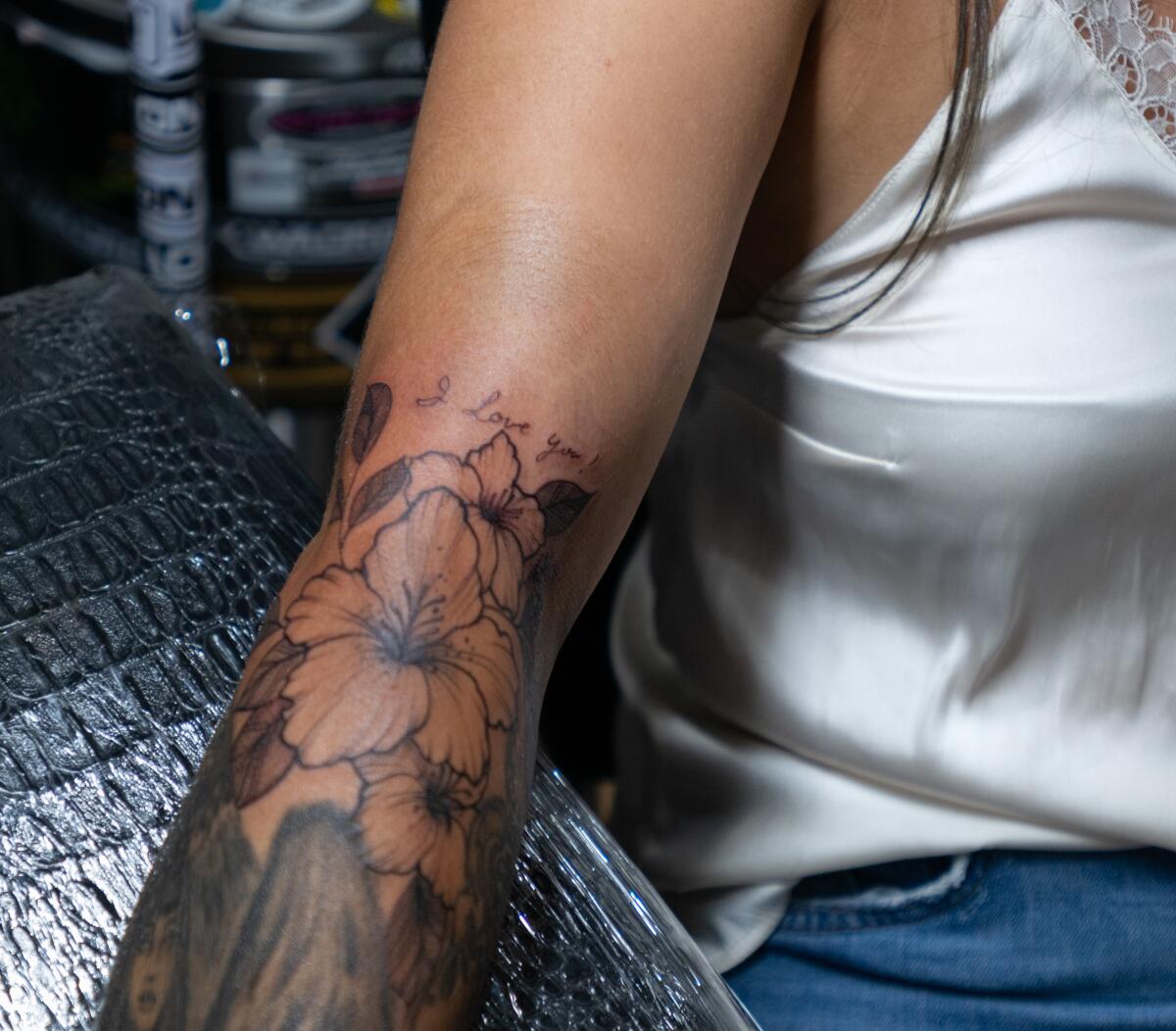
Resources
Need a vaccine? Keep in mind that supplies are limited, and getting one can be a challenge. Sign up for email updates, check your eligibility and, if you’re eligible, make an appointment where you live: City of Los Angeles | Los Angeles County | Kern County | Orange County | Riverside County | San Bernardino County | San Diego County | San Luis Obispo County | Santa Barbara County | Ventura County
Practice social distancing using these tips, and wear a mask or two.
Watch for symptoms such as fever, cough, shortness of breath, chills, shaking with chills, muscle pain, headache, sore throat and loss of taste or smell. Here’s what to look for and when.
Need to get tested? Here’s where you can in L.A. County and around California.
Americans are hurting in many ways. We have advice for helping kids cope, resources for people experiencing domestic abuse and a newsletter to help you make ends meet.
We’ve answered hundreds of readers’ questions. Explore them in our archive here.
For our most up-to-date coverage, visit our homepage and our Health section, get our breaking news alerts, and follow us on Twitter and Instagram.




